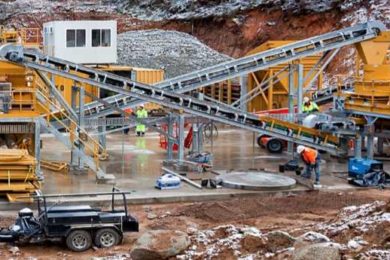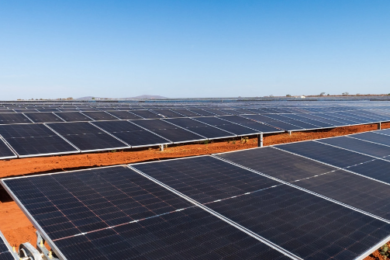HAZEMAG & EPR is a concern that evolved from the merging of two separate German companies, both of which have good reason to celebrate. Hazemag is celebrating 60 years this year, and EPR over 100 years more. During its long and varied history, the Eisenhütte Prinz Rudolph (Prince Rudolph Foundry), which has been resident in Dülmen, Westphalia for some 165 years, has progressed from its beginnings as the first industrial firm in Dülmen to a successful specialist manufacturer of mining and tunnelling equipment.
The Prince Rudolph Foundry was established in 1842 and, by being aware of the economic situation of the time, developed from a conventional foundry to a much sought after specialist in the manufacture of mining machinery. The company benefited from the growth of the coal mining industry in the Ruhr and became a significant player in this field; this connection still exists today. Currently, EPR supplies mainly components for tunnelling, loading & dinting and drilling equipment under the TURMAG, HAUSHERR and Salzgitter brands. Since the long-term future of the mining industry in Germany is rather bleak, the company at a very early stage re-orientated itself towards overseas markets. Mining machinery is now exported, principally to Eastern European countries, Russia and China, in other words, those markets where coal mining is an expanding industry. It is now a matter of adapting the technology of well-proven, reliable and dependable machinery to meet the new demands, “a permanently challenging task for our designers and engineers,” the company says.
More than 60 years ago – on August 14, 1946, Dr. Ehrhardt Andreas and Richard Rendemann applied for the registration of the company HAZEMAG in the Commercial Register in Münster. It is almost impossible to imagine the extremely difficult circumstances under which the first machines were fabricated in a Germany totally devastated as a result of WWII. The two founders of the company must have enjoyed a large slice of optimism and incredible business acumen to found a new company at this time. The basis on which the company was established was the HAZEMAG ANDREAS-type impact crusher. The brother of the founder, Arno Andreas, had already tested this innovative crushing system in Berlin during the war. In the aftermath of the war, this new impact crusher proved its superiority over other crushing systems in the necessary processing of the huge amounts of building rubble in the bombed-out cities and towns of Germany.
There was certainly no lack of material to be processed and, within a short time of its founding, the company had sold more than 150 crushers, which converted the useless rubble into the high quality aggregate and chippings needed for reconstruction purposes.
With the reduction in the amount of rubble available for processing, the crushers were adapted and deployed mainly in the crushing of non-metallic minerals such as limestone, gypsum, shale, coal and hard rock, all of which were available in large quantities. Of notable success were the applications in the global cement and gravel industries.
The company has come a long way from the rather primitive beginnings of debris processing to the construction of the world’s largest rubble recycling plant. Much midnight oil was burnt during the preparations for this ambitious project prior to the signing of the contract in Dubai in December, 2007.
Today, HAZEMAG products are used in practically all branches of raw material recycling and recovery. Impact crushers, hammer crushers, roll crushers, hammer mills, dryers, apron conveyors, wobbler feeders, push feeders, impact separators and hard materials separators are used effectively in various combinations for the design of efficient and reliable plants.
In 1988, Salzgitter Maschinenbau acquired the facilities in Münster and re-located in Dülmen together with one of its other companies, the former Eisenhütte Prinz Rudolph (EPR). Following re-organisation within the Preussag group of companies, HAZEMAG became part of Noell Service- und Maschinentechnik. Finally, in 1999 the whole Dülmen location was taken over by Messrs. Schmidt Kranz & Co., and made into an independent limited company (GmbH), since which it has been known as HAZEMAG & EPR GmbH, Dülmen.
In 2006, the company enlarged its product range by taking over the Mineral Processing Division (MinPro) of DBT in Lünen. The line of products from MinPro covers through-flow crushers for primary crushing stages as well as scraper chain conveyors. All the crushers from this new division operate on the horizontal flow principle, and have proved their operational reliability and safety value in many applications above and below ground for the processing of coal, potash and salt, non-metallic minerals, ore and rubble recycling.
With an approximately 300-strong work force, HAZEMAG & EPR is a medium-sized company located in the pleasant country town of Dülmen in Münsterland, manufacturing steel products ranging from conventional- to giant-size to customers all over the world.
On May 16, 2008, customers and business associates have the opportunity to see the whole company with a stroll round the premises and through the fabricating shops, to form their own impression of the capabilities and efficiency of the company. In a well-preserved building dating from the founding years of the company, there is a display illustrating the background history and giving an insight into those former days.
On May 18, 2008, HAZEMAG & EPR will open its gates to employees and their relatives as well as interested member of the public. This ‘open day’ offers the opportunity to see what goes on behind the (usually) locked doors of the company. There will be an interesting programme for large and small which will certainly make this day a memorable









